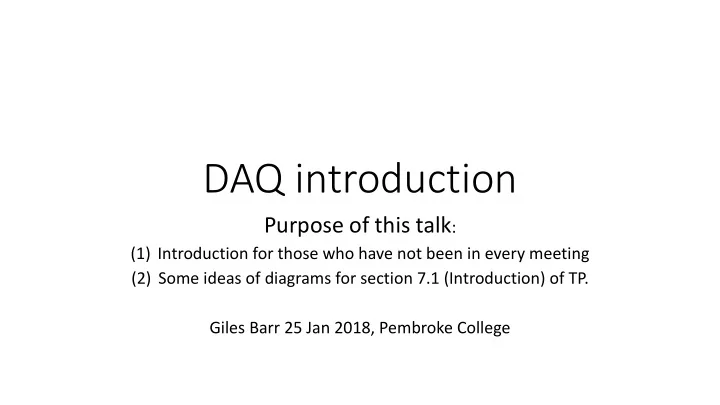

DAQ introduction Purpose of this talk : (1) Introduction for those who have not been in every meeting (2) Some ideas of diagrams for section 7.1 (Introduction) of TP. Giles Barr 25 Jan 2018, Pembroke College
On DUNE, the reality is there is a lot of data, so we store the data and don't move it while the decisions are made. Parallelize This model works well for a WaterC detector, all the data passed along the chain as the decision is made. Merge data into blocks, Processing steps view O(size of APA) Prepare for trigger primitive search: time order, light filtering Trigger primitive search Collect data into bigger blocks Trigger decisions (per interaction) Carve out data (events) for around trigger decisions Perform secondary trigger decisions Decisions to store large window of SN data
Triggers • Expected triggers and reasons for collecting (from Josh's talk): • Beam interactions (spills 1/sec but only keep if some activity) • Cosmics (+atmospheric nu) • Radiologicals • SNBs – Specially long readout window etc. • Other low energy events (one drift length about to collect) • Calibrations: Front-end, Radioactive source, Laser • Random triggers • Nuclear excitation studies (pre-scaled windows after cosmics) • Recap previous slide: There is a lot of data, so we parallelize and don't move it around too much. • At least two storage areas • Continuous raw data ring-buffer storage, aim for at least 10 secs • Several hours of events we might keep if close to SN. (For SNEWS, LIGO alert, etc.). • Probably also a 'quick stash' store to save the ring buffer when we trigger an SN ourselves
Secondary selection 3 6 1 2 5 4 4
Other diagrams There are other views of the system we have thought up. • Some on next slides • We have the main concepts that we want to show in the introduction to the TP, TODO: pick the best way to show it • Will select which views to present in intro, and which views to talk about in dataflow section in a dedicated dataflow agenda item later this morning. • Also tables are important: Need table of triggers up front, with enough numbers to give reader overview of size of system while they are still in the intro. • TP will be used by review committees in different countries to assess relevance of home contributions, so we must not relegate the less immediate components e.g. secondary trigger
Slide showing timing since interaction Note: This is an old picture, needs updating for TP
Tables: Old, from CD1-R, (3 tables like this) New, under construction, see later talks. From J. Klein talk 16012018
Summary • We have already made some key architecture decisions and are lining up others (Dave's previous talk). • We should choose what info to present in the TP introduction. It will probably be one or two of the diagrams above, a list of key requirements and a table giving rates in the system, and flowing out of the system. • The next level of detail is the main buffering areas, a description of how/when each is used, and what the latencies are (as imposed by these buffers). • Maybe we don't decide all this now, but can look at the next talks to discuss the more detailed bits and then come back to these.
Recommend
More recommend